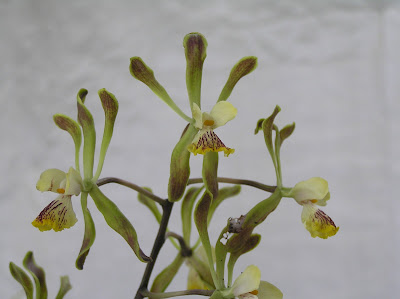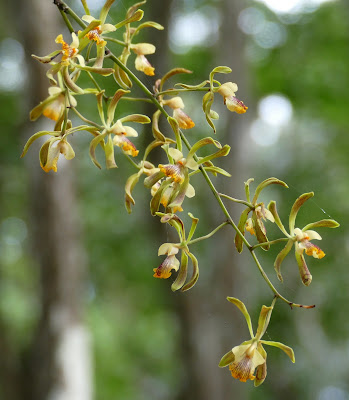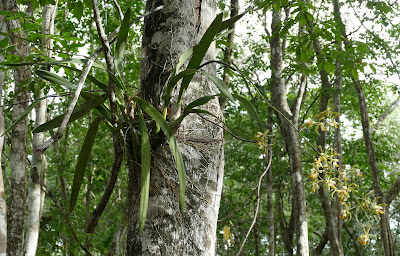Encyclia alata - Winged Encyclia flowers are scented, sepals and petals basally olive or pale green, distally dark red-brown; lip yellow or green...
Encyclia alata, also called as Winged Encyclia, Epidendrum alatum, is a species in the genus Encyclia. This species was described by Friedrich Richard Rudolf Schlechter in 1914.
DESCRIPTION OF ENCYCLIA ALATA - WINGED ENCYCLIA
Encyclia alata is native to Southern Mexico to Central America. It is found growing on trees, occasionally in soil, in open forests in Belize, Costa Rica, El Salvador, Guatemala, Honduras, Mexico Gulf, Mexico Southeast, Nicaragua, Panamá at elevations of 0-1000 meters above sea level.
It is a medium to large sized, hot to warm growing species which reaching to 90 cm in height with ovoid-conical to pyriform pseudobulbs that are subtended by papery sheaths. The leaves are 1 to 3, apical, linear-lanceolate, acute, tough and often tinged with purple, 20-55 x 1.3-5.0 cm.
Winged Encyclia blooms in spring through fall from the apical, to 150 cm long, arching, branched inflorescence. Flower color and shape vary considerably between individuals. Generally, the flowers are long-lasting, showy, resupinate, spreading, scented, sepals and petals basally olive or pale green, distally dark red-brown; lip yellow or green, cream with yellow margins, veins dark red; the lateral lobes basally stripped with dark red, callus reddish spotted.
ENCYCLIA ALATA - WINGED ENCYCLIA CARE AND CULTURE
Cultural information should only be used as a guide, and should be to be adapted to suit you. Your physical location; where you grow your plants, how much time you have to devote to their care, and many other factors, will need to be taken into account. Only then can you decide on the cultural methods that best suit you and your plants.
Light:
Encyclia alata needs a light level of 25000-35000 lux. The light should be filtered or diffused and the plants should not be exposed to direct midday sun. Strong air movement should be provided all the time.
Temperature:
In summer, the average day temperature is 27-30 °C, and the night 17-19 °C, with a daily amplitude of 8-10 °C. In winter the average daytime temperatures are 25-27 °C, and 16-18 °C during the night, while the daily amplitude is 8-11 °C.
Humidity:
Winged Encyclia needs the humidity of 80% in the period of growth, in winter and spring it falls to 60-70%. Too dry air has a negative effect on the development of the plant: its growth is inhibited, and the leaves begin to turn yellow and dry out. The higher temperature, the higher the humidity should be, and the higher the humidity, the more often and longer it is necessary to ventilate the room where the plants are contained, otherwise the probability of rotting and various kinds of fungal diseases. Good air movement is essential while the plants are in leaf and growing.
Substrate, growing media and repotting:
Encyclia alata grow well mounted on pieces of tree fern or cork, but in summer this requires high humidity and daily watering. In the period of extremely hot and dry weather, fixed plants may require even several watering times a day.
However, since most growers find it too difficult to maintain sufficient moisture with this growing method, these plants are usually grown in pots using an airy, fast-drying substrate that contains substances such as perlite to keep moisture out and charcoal to keep it airy and prevent acidification. Plants should be repotted at the end of winter or early spring, when new root growth begins.
Watering:
The plants should be watered abundantly during active growth, but their roots must dry out quickly after watering. At the end of autumn, the amount of water should be gradually reduced.
Fertilizer:
Winged Encyclia should be fertilized every week 1/4-1/2 of the recommended dose of fertilizer for orchids. A fertilizer with a high nitrogen content is beneficial from spring to mid-summer, and a phosphorus-rich fertilizer can be used in late summer and autumn. Higher phosphorus content stimulates better flowering in the next season and promotes hardening of new growth before winter.
To avoid the accumulation of mineral deposits during periods of strong fertilization, it is recommended to rinse the containers approximately every month.
Rest period:
Encyclia alata grown in cool conditions should be kept relatively dry in winter, with occasional fogging between rare waterings. However, those grown in warmer conditions need more water and significant drying up between waterings. However, it must not be allowed keep them dry for a long time. Fertilization should be reduced or eliminated until new growths appear and watering begins more abundantly in the spring.

















COMMENTS